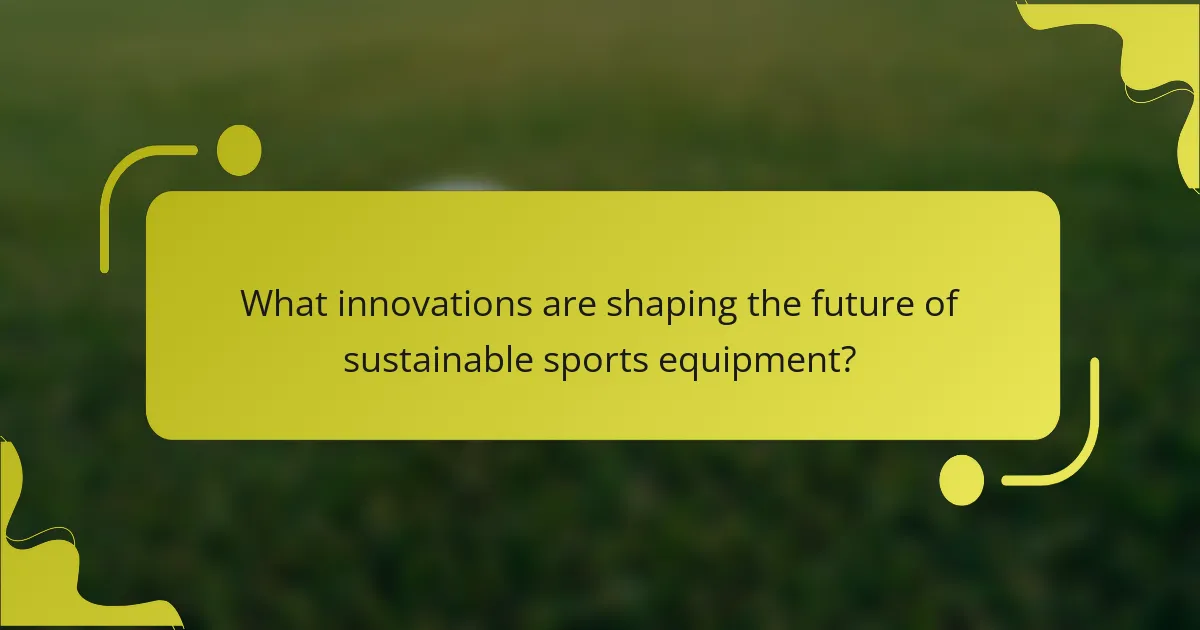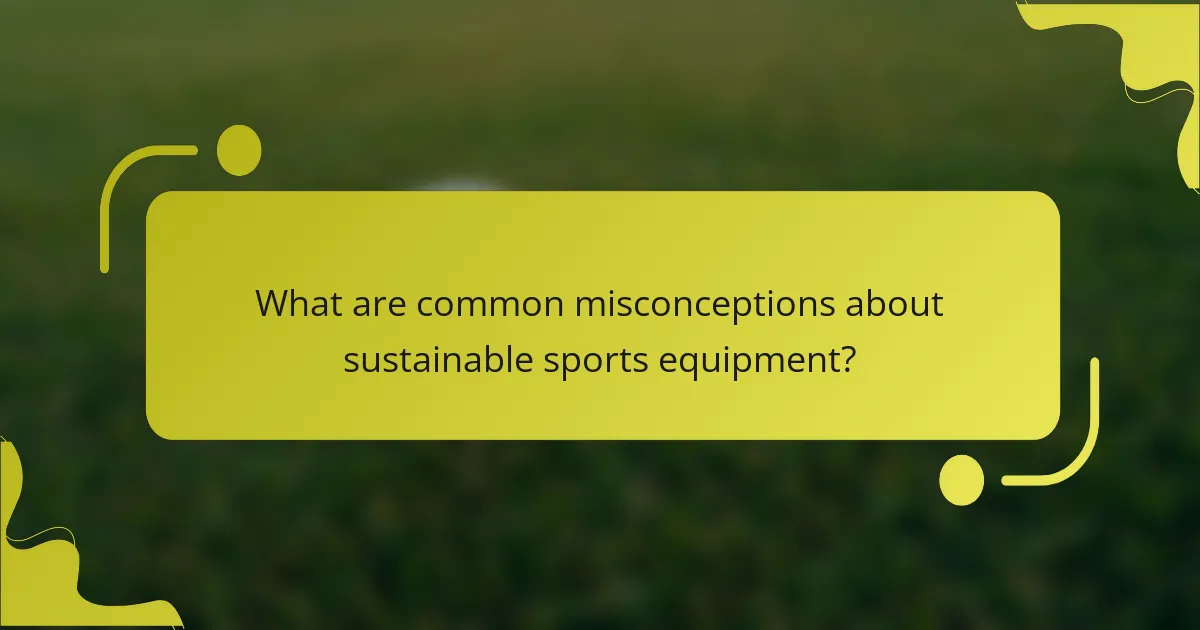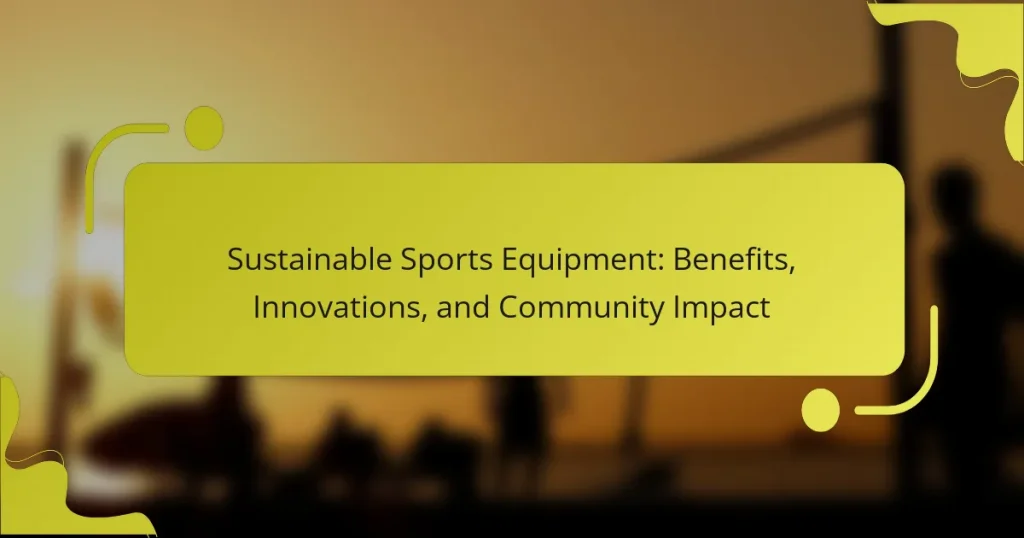Sustainable sports equipment significantly reduces environmental impact while enhancing performance. This article explores the benefits of eco-friendly materials, innovations in production processes, and the positive effects on community health. It also addresses economic advantages and common misconceptions about sustainable options. By understanding these aspects, consumers can make informed choices that support both the planet and their active lifestyles.

What are the environmental benefits of sustainable sports equipment?
Sustainable sports equipment offers significant environmental benefits by reducing waste and minimizing carbon footprints. These products often use eco-friendly materials, which decrease pollution and conserve resources. Additionally, they promote a circular economy through recycling and upcycling initiatives. By choosing sustainable options, consumers support environmentally responsible practices and encourage manufacturers to innovate further in eco-friendly designs.
How does sustainable sports equipment reduce carbon footprints?
Sustainable sports equipment significantly reduces carbon footprints by using eco-friendly materials and production methods. These innovations minimize waste and energy consumption during manufacturing. For example, biodegradable plastics and recycled metals lower greenhouse gas emissions. Additionally, sustainable equipment often promotes a circular economy, encouraging reuse and recycling, which further decreases overall environmental impact.
Which materials contribute to eco-friendliness in sports gear?
Eco-friendliness in sports gear is enhanced by materials such as recycled plastics, organic cotton, and natural rubber. These materials reduce environmental impact and promote sustainability. Recycled plastics, for example, repurpose waste into functional gear, while organic cotton avoids harmful pesticides. Natural rubber offers durability without synthetic chemicals, contributing to a healthier planet. By choosing these materials, brands can innovate while fostering community awareness and environmental responsibility.

What innovations are shaping the future of sustainable sports equipment?
Innovations in sustainable sports equipment focus on eco-friendly materials, energy-efficient manufacturing, and circular economy practices. These advancements reduce environmental impact and enhance performance. For example, brands are using recycled plastics and organic textiles, which contribute to lower carbon footprints. Additionally, smart technology integration improves durability and user engagement, fostering community awareness about sustainability.
How are technology and design improving sustainability in sports gear?
Technology and design are enhancing sustainability in sports gear through innovative materials and efficient manufacturing processes. Sustainable sports equipment reduces environmental impact by utilizing recycled materials and biodegradable components. For example, brands are integrating advanced textiles that minimize waste during production. Innovations like 3D printing allow for on-demand manufacturing, reducing excess inventory and energy use. Community impact is significant, as sustainable practices encourage consumer awareness and promote eco-friendly values in sports culture. This shift not only benefits the planet but also enhances brand loyalty among environmentally conscious athletes.
Which brands are leading the way in sustainable sports equipment innovations?
Leading brands in sustainable sports equipment innovations include Patagonia, Adidas, Nike, and The North Face. These companies focus on eco-friendly materials, ethical production practices, and community initiatives. For example, Adidas has developed shoes made from ocean plastic, showcasing a unique approach to reducing waste. Nike’s Move to Zero campaign emphasizes carbon neutrality and sustainable sourcing. The North Face promotes circularity through its reuse and recycling programs. These innovations not only enhance performance but also contribute positively to environmental and social impacts.

How does sustainable sports equipment impact community health and wellness?
Sustainable sports equipment enhances community health by promoting physical activity and environmental awareness. It encourages active lifestyles, reduces carbon footprints, and fosters social connections. For instance, communities using eco-friendly equipment report increased participation in sports and outdoor activities, contributing to overall wellness. Additionally, innovations in sustainable materials improve durability and performance, attracting more users. As a result, healthier populations emerge, benefiting both individual and community well-being.
What role does sustainable sports equipment play in promoting active lifestyles?
Sustainable sports equipment significantly promotes active lifestyles by reducing environmental impact and enhancing user engagement. These products often feature eco-friendly materials, which appeal to environmentally conscious consumers. Innovations in design and technology improve performance, making physical activities more enjoyable. Community initiatives around sustainable sports equipment foster social connections and collective participation in fitness activities, further encouraging an active lifestyle.
Which community initiatives are using sustainable sports gear to foster engagement?
Community initiatives are increasingly using sustainable sports gear to enhance engagement and promote environmental responsibility. These initiatives focus on eco-friendly materials, such as recycled plastics and organic fabrics, which reduce waste and carbon footprints.
Programs like “Green Sports Alliance” collaborate with schools and local teams to provide access to sustainable equipment, fostering a culture of sustainability among young athletes. Another example is “EcoAthletes,” which encourages athletes to advocate for environmental issues, using their platforms to raise awareness.
Research indicates that communities adopting sustainable sports gear see increased participation and a stronger sense of belonging. This shift not only benefits the environment but also cultivates a healthier lifestyle among participants.

What are the economic advantages of investing in sustainable sports equipment?
Investing in sustainable sports equipment offers significant economic advantages. These include reduced long-term costs, increased market demand, and potential tax incentives.
Sustainable materials often lead to lower production costs due to energy efficiency. For example, companies using recycled materials can save on raw material expenses. As a result, businesses can pass savings to consumers, enhancing competitiveness.
The growing consumer preference for eco-friendly products drives demand. This trend opens new market opportunities for companies that invest in sustainable equipment. Additionally, government incentives for green practices can further offset initial investment costs.
Overall, sustainable sports equipment not only supports environmental goals but also fosters economic growth through innovation and market expansion.
How can sustainability in sports gear lead to cost savings for consumers?
Sustainability in sports gear can lead to cost savings for consumers through reduced long-term expenses. Eco-friendly materials often have enhanced durability, decreasing replacement frequency. Additionally, sustainable manufacturing processes can lower production costs, which may be passed on to consumers. As awareness of environmental impact grows, brands adopting sustainability may attract more customers, leading to economies of scale and lower prices. Overall, investing in sustainable sports equipment can yield financial benefits while promoting environmental responsibility.
Which markets are emerging for sustainable sports equipment?
Emerging markets for sustainable sports equipment include North America, Europe, and Asia-Pacific. These regions are increasingly prioritizing eco-friendly practices and materials in sports gear production.
North America sees a rise in demand for sustainable products, driven by consumer awareness and brand commitment to environmental responsibility. Europe leads in regulatory measures promoting sustainability, encouraging innovation in equipment design. Asia-Pacific is expanding rapidly, with investments in sustainable manufacturing processes and materials.
As a result, brands are innovating with biodegradable materials, recycled plastics, and energy-efficient production methods. This shift not only addresses environmental concerns but also enhances community engagement and health benefits.

What unique attributes differentiate various types of sustainable sports equipment?
Various types of sustainable sports equipment differ through attributes like materials, production processes, and lifecycle impacts.
For example, biodegradable materials enhance environmental benefits, while upcycled components reduce waste. Innovations such as modular designs allow for easy repairs, extending product lifespan. Community impact varies; some brands engage in local manufacturing, supporting economies and reducing carbon footprints. Unique attributes, like certifications for fair trade or organic sourcing, further distinguish these products.
How do performance and durability compare among sustainable sports gear?
Sustainable sports gear often balances performance with durability effectively. Many brands leverage eco-friendly materials that enhance longevity while maintaining high functionality.
For instance, recycled polyester can offer comparable durability to traditional fabrics, while natural fibers like hemp provide excellent breathability. Innovations like biodegradable composites also contribute to performance without compromising sustainability.
The community impact of using such gear includes reduced waste and lower environmental footprints, promoting a healthier planet. As a result, athletes increasingly favor sustainable options, recognizing their dual benefits.
Which niche products exemplify unique sustainable practices in sports equipment?
Innovative products like biodegradable tennis balls and recycled plastic surfboards exemplify unique sustainable practices in sports equipment. These items reduce environmental impact while maintaining performance. Brands like Wilson and Firewire are leading this change, showcasing how sustainability can enhance community engagement and promote eco-friendly practices in sports.

What are common misconceptions about sustainable sports equipment?
Many misconceptions exist about sustainable sports equipment, primarily regarding its performance and cost. Some believe that sustainable options compromise quality, but innovations have proven otherwise. For instance, eco-friendly materials can enhance durability and performance. Additionally, the perception that sustainable equipment is prohibitively expensive is misleading; many affordable options are now available, making them accessible to a broader audience. These misunderstandings can hinder the adoption of sustainable practices within the sports community, ultimately impacting environmental efforts.
How can consumers identify truly sustainable sports products?
Consumers can identify truly sustainable sports products by evaluating materials, certifications, and brand transparency. Look for equipment made from recycled or organic materials, which reduces environmental impact. Certifications like Fair Trade or Global Organic Textile Standard indicate adherence to sustainable practices. Additionally, brands that openly share their supply chain processes demonstrate commitment to sustainability. Engaging with community initiatives can also reflect a brand’s genuine efforts towards sustainability.
What challenges do manufacturers face in creating sustainable sports gear?
Manufacturers face significant challenges in creating sustainable sports gear, including sourcing eco-friendly materials, ensuring durability, and managing production costs. The transition to sustainable materials often involves higher upfront costs and limited availability of high-performance alternatives. Additionally, manufacturers must navigate consumer expectations for performance while adhering to environmental standards. Balancing innovation with sustainability creates complexities in design and manufacturing processes.
What best practices can consumers follow when choosing sustainable sports equipment?
Consumers should prioritize durability, materials, and certifications when choosing sustainable sports equipment. Selecting products made from recycled or eco-friendly materials reduces environmental impact. Look for certifications like Fair Trade or Global Organic Textile Standard to ensure ethical production. Additionally, consider the brand’s commitment to sustainability and community initiatives. Supporting companies that give back fosters a positive community impact.




